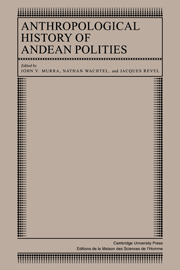Book contents
- Frontmatter
- Contents
- List of contributors
- Preface
- Introduction
- Part I Ecology and society
- Part II The ethnic group and the state
- Part III Systems of classification
- 8 Some aspects of the Inka kinship system
- 9 The classification and naming of South American camelids
- 10 The semiology of Andean textiles: the talegas of Isluga
- Part IV Symbolic representations and practices
- Part V From ethnic polities to communities
- Bibliography of published source
- Index
10 - The semiology of Andean textiles: the talegas of Isluga
Published online by Cambridge University Press: 05 October 2010
- Frontmatter
- Contents
- List of contributors
- Preface
- Introduction
- Part I Ecology and society
- Part II The ethnic group and the state
- Part III Systems of classification
- 8 Some aspects of the Inka kinship system
- 9 The classification and naming of South American camelids
- 10 The semiology of Andean textiles: the talegas of Isluga
- Part IV Symbolic representations and practices
- Part V From ethnic polities to communities
- Bibliography of published source
- Index
Summary
Andean textiles, especially the archaeological ones, have been the subject of many studies. Questions have been asked about technique, use, chronology, style, and spatial and ethnic distribution. Still one can say that the specific language of the fabrics has been ignored, despite the valuable anthropological contributions made by these studies. From an iconographical point of view, attempts have been made to identify figurative motifs (flora, fauna, mythical scenes) or to interpret abstract forms that suggest the presence of more or less recognizable symbols. Efforts to isolate a possible lexicon, using a hierarchy exterior to the design, have started with the most immediately legible (head, sun, hut), but the syntax that would explain how such elements are articulated within the whole of the cloth remains unknown.
What, then, shall we do when confronted by a hermetical landscape of bands and stripes or, even worse, one made up of empty space? We consider the questions, Can a traditional Andean textile be viewed as a text – not as a decoration or an illustration of realities outside the woven cloth but as a specific message behind which lies a system that explains the message? What are the conventions of this code? What are its minimal units? To what extent is the woven text comprehensible within but also beyond the Andean communities in which it has been elaborated?
My examples come from among the textiles studied during fieldwork at Isluga, an Aymara township on the Chilean altiplano in the province of Tarapacá. Its territory includes stark cordilleras, narrow valleys, and high plains, with occasional swamps. It stretches between two salt lakes: Surire, to the north, and Coipasa, to the southeast.
- Type
- Chapter
- Information
- Anthropological History of Andean Polities , pp. 149 - 174Publisher: Cambridge University PressPrint publication year: 1986
- 24
- Cited by



